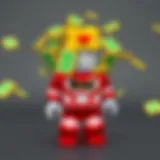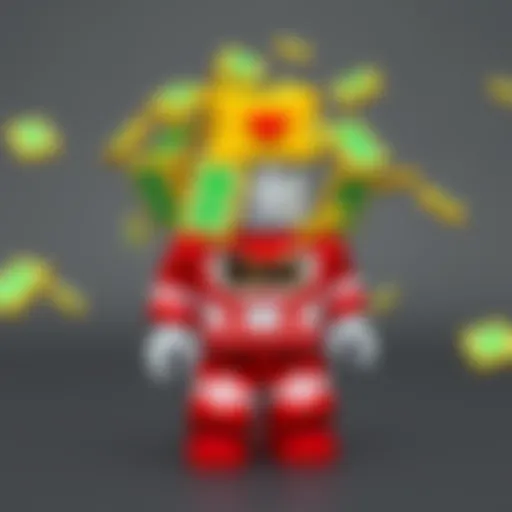Exploring Distortion Sound Effects in Gaming


Intro
In the realm of gaming, where visuals often steal the spotlight, sound plays a crucial role that can’t be overlooked. One particular aspect of sound design, the distortion effect, serves to create a unique, immersive experience. It’s not just about crunching the audio; it’s about changing perceptions. This distortion can alter how players engage with their environments, flinging them into realms that evoke tension, excitement, or even nostalgia.
Distortion sound effects are versatile tools, giving developers the ability to shape and manipulate audio landscapes. They can turn the most mundane moment in gameplay into something extraordinary by altering sound waves in ways that enhance gameplay and storytelling. In this article, we will delve into the layers of distortion sound effects in gaming, analyzing their significance, functionality, and real-world applications— particularly focusing on platforms like Roblox where user-generated content thrives.
As we navigate through this discussion, we’ll examine how the nuances of sound can weave into the very fabric of gameplay. So, whether you're a seasoned veteran in game development or a novice creator simply looking to spice up your projects, there’s something here for everyone. Let's explore how distortion enhances the auditory experience in ways that can transform player engagement and overall satisfaction.
Foreword to Distortion Sound Effects
When diving into the vibrant world of gaming audio, distortion sound effects stand as a compelling element. They do more than just alter sounds; they create an auditory landscape that can elevate a player’s experience from mundane to extraordinary. The importance of understanding distortion effects lies in their ability to shape not only the mood of a game but also the emotional responses of players. Each crunch, crackle, and shift in tone can significantly contribute to gameplay – something that budding developers and seasoned creators must grasp.
Defining Distortion in Audio
Distortion, in an audio sense, refers to any alteration of an original sound wave, leading to modifications in its tonal qualities. This alteration might be as simple as adding harmonics that weren't present initially or as complex as warping the sound entirely, causing it to morph into something alien. At its core, distortion can be polarized into two categories: intentional and unintentional.
Intentional distortion is the choice of sound designers to inject a raw edge into music or sound effects, creating a feeling of chaos or intensity. Think of a guitar riff that’s been cranked up, where notes ooze with grit and texture. On the other hand, unintentional distortion can arise from factors like poor recording quality or a lack of sound conditioning. Just imagine capturing an ambiance of a rustling forest only to end up with static noise – not ideal for a serene gaming experience.
In gaming, this distinction plays a crucial role. Developers can manipulate distortion to evoke specific feelings in players, be it tension, excitement, or intrigue. Choices made in the studio can leave a lasting impression as players navigate through worlds filled with both challenge and wonder.
Historical Context of Distortion Effects
Understanding the evolution of distortion effects brings insight into how gamers and developers perceive sound. Historically, distortion traces back to the raw sounds of blues and rock music, where artists pushed equipment beyond its normal limits to create a ‘fuzzy’ or ‘overdriven’ aesthetic. This edge became iconic, paving the way for its adoption in genres that thrive on intensity.
As technology progressed, so did the application of distortion in various media. With the rise of digital audio workstations in the ’80s and ’90s, distortion effects became much more accessible to musicians and, subsequently, sound designers. Video games emerged as fertile ground for experimentation with these techniques. Early titles like "Doom" and "Quake" used simple, repetitive sound effects that benefited from distortion to immerse players in engaging and hostile environments.
More recently, games like "Dead Space" have taken distortion a step further, layering soundscapes and blending various distortion types to evoke feelings of dread. This development speaks volumes to the importance of distortion—the ability to affect player reactions and to shape the storyline using nuanced audio cues. As such, distortion is not merely a technical choice but an artistic one, anchored deeply in the legacy of gaming itself.
"When sound becomes a character in itself, distortion becomes its voice."
Armed with a historical lens, we can appreciate how distortion has secured its place in gaming audio design. It’s not just an add-on; it factors into the core sensory experience. Much like a good storyline, sound works best when it invites players to lose themselves in the world developers have crafted.
Mechanics of Distortion Sound Effects
The mechanics behind distortion sound effects are crucial in shaping the audio experience in gaming. They offer unique ways to manipulate sound, providing depth and character that can elevate gameplay. Understanding these mechanics allows developers to create immersive worlds that resonate with players on multiple levels. This section delves into the key elements of distortion, examining how various types of distortion effects can be harnessed effectively.
Understanding Waveform Manipulation
At the heart of distortion sound effects lies the concept of waveform manipulation. Every sound is represented by a waveform, a graphical depiction of the sound wave that shows its amplitude over time. By altering this waveform, sound designers can create a range of auditory experiences.
For instance, when a waveform is manipulated, you can achieve effects ranging from subtle warmth to intense, chaotic sounds. The manipulation sometimes occurs during the audio recording process or through software tools that allow developers to shape the sound in real-time. This capability is especially vital in gaming, where the environment can change swiftly and require immediate audio adaptation.
Manipulating a waveform can also happen through processes like clipping or adding effects that enhance certain frequencies. These adjustments can create a fuller, richer audio landscape, immersing players deeper into the game. The goal is to engage the player’s emotions and enhance their overall experience through thoughtful sound engineering.
Types of Distortion Effects
There are several notable types of distortion effects, each with its own flavor and application in game audio design. Here’s a closer look at these effects:
Overdrive
Overdrive is often recognized for its warm saturation and dynamic range. It’s particularly popular among sound designers looking to add a bit of grit without overwhelming the listener. The key characteristic of overdrive is how it enhances a sound’s harmonics while maintaining its core essence.
This effect is beneficial for genres that call for intensity, such as action or racing games. It adds a layer of excitement and urgency, engaging players more deeply. One unique feature of overdrive is how it can fill out the mix without consuming too much headroom in the overall sound.
However, an overzealous use of overdrive can lead to muddiness in the audio, potentially overshadowing other elements. Thus, a careful balance is crucial to capitalize on its strengths.
Fuzz
Fuzz takes distortion to a different level, marked by its aggressive sound and unique tonal characteristics. It’s often associated with guitars but can be creatively applied to any sound source, giving it a distinct edge. The significant aspect of fuzz is its ability to create a thick, wall-of-sound effect that can transport players directly into the action.
In gaming, fuzz can elevate dramatic moments, adding a sense of chaos or intensity. It's a go-to choice for abstract or surreal games where sound plays a critical role in conveying emotion. A notable feature of fuzz is its unpredictable nature, which, while captivating, can sometimes lead to a lack of clarity. Hence, used wisely, it can become a powerful tool in a game’s audio toolkit.
Bitcrushing
Bitcrushing is a unique form of distortion that reduces the audio bit depth, resulting in a gritty, lo-fi sound. By breaking down the audio signal into lesser bits, developers can achieve a retro vibe that resonates with nostalgia. This effect has grown popular in indie games, where aesthetic choices often lean towards pixel art styles.
The key characteristic of bitcrushing is its ability to create a raw, unpolished sound, imbuing a sense of authenticity. Players often find themselves emotionally connected to such sounds, evoking memories of earlier gaming eras. However, while bitcrushing can add charm, it can also lead to a loss of audio quality if not implemented carefully. Sound designers should ensure it serves a specific purpose within the game.
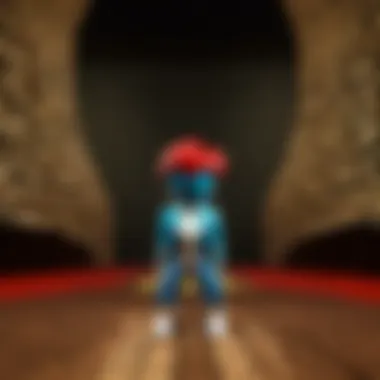

Clipping
Clipping occurs when the audio level exceeds the system’s maximum limit, which can lead to a defined, almost aggressive distortion of the sound. While it might sound harsh, clipping can generate a timeless quality that some players find enjoyable. The primary aspect of clipping is how it can both shock and engage players, often making them sit up and take notice.
This technique can be particularly effective in areas where you want to create immediate reactions, such as jump scares in horror games. One unique feature of clipping is how it can emphasize specific elements in a mix, drawing attention to crucial sound effects. However, excessive clipping can lead to audio fatigue, making moderation essential to maintain an enjoyable overall experience.
Role of Distortion in Game Audio Design
The landscape of gaming audio is not just a backdrop but a dynamic element that shapes players' experiences. Understanding the role of distortion within game audio design is vital for creators aiming to foster engagement and elevate gameplay. Using distortion wisely can significantly influence how players perceive a game, evoking varied emotions and enhancing the overall experience. In this section, we explore the significance of distortion in crafting immersive soundscapes that resonate with players.
Creating Atmosphere and Mood
In the realm of gaming, atmosphere plays a crucial role. Distortion can be employed to craft an emotional backdrop that complements the narrative and visual elements of a game. For instance, imagine a horror game where each creak, whisper, and thunderous sound is distorted. The screech of a rusty door or the low growl of an unseen creature can send chills down the spine, making players hyper-aware of their surroundings. Such sound manipulation feeds into the players’ psyche, creating a palpable tension that enhances the fear factor.
In games like "Silent Hill", the use of distortion in the soundtrack exemplifies how sound can envelop players in psychological horror. The intrusive sounds of static or distorted voices heighten feelings of dread and uneasiness, making players feel as though they are part of a waking nightmare. This interplay between sound design and atmosphere demonstrates that distortion is not merely an artistic choice—it's a powerful tool that can make or break the immersion.
Enhancing Gameplay Immersion
To bolster immersion, distortion effects can be deliberately introduced during high-stakes moments. Imagine a racing game where driving through shortcuts causes engines to roar wildly, the sound distorted to reflect the adrenaline rush. This technique amplifies excitement and engagement, creating a more visceral experience for players. When they feel the weight of their actions echoed through sound, they become more invested in the game.
Moreover, when distortion is used to differentiate sound layers, it can guide players' actions and responses in real time. For example, in action-adventure games, unique distortion effects might signal changes in enemy behavior or an impending boss battle. This audio cue system serves as both an alert and an immersive narrative device, drawing players deeper into the game mechanics.
"Sound is the very heartbeat of gaming; distortion is the pulse that quickens it."
Implementing Distortion Effects in Game Development
In the realm of game development, embedding distortion sound effects can provde a notable edge, transforming basic game audio into a journey. It’s not just about slapping some effects on a sound; rather, it’s about the thoughtful integration that enriches gameplay. This section dives into key components of implementing these effects, highlighting necessary software, best practices for sound layering, and methods to finely tune parameters to achieve the desired auditory results.
Software and Tools for Sound Design
Choosing the right tools is crucial, as different software packages offer varying capabilities. Some options are really popular within the gaming community:
- Ableton Live - It’s versatile and perfect for both live performances and sound design. Ableton lets you shape sounds in real-time with various effects, which is ideal for testing distortion in a vibrant setting.
- FL Studio - This DAW (Digital Audio Workstation) is renowned for its user-friendly interface, which can be a plus for beginners. It offers extensive plugins that can manipulate sound beautifully.
- Pro Tools - While it has a steeper learning curve, this tried-and-true option provides unparalleled audio fidelity. Great for complex games that rely on high-quality sound.
- Audacity - An open-source option good for simpler edits, perfect for those just dipping their toes in sound design without breaking the bank.
Additionally, including third-party plugins can enhance your distortion palette. Items like Guitar Rig or Waves Audio Plugins can be integrated to create richer distortion layers.
Best Practices for Layering Sounds
Layering sounds is an art. It’s about combining various audio elements to create texture and depth. Here are some strategies:
- Start Simple: Begin with a clean base sound before adding layers of distortion. This allows more control over the final output.
- Use Varied Sources: Mixing different audio sources (like Foley sounds, synthesized noise, etc.) can create a more immersive environment. Each layer can introduce its own nuances, making the sound richer.
- Control Volume Levels: Make sure to keep an eye on levels while layering. An overwhelming distortion can create audio fatigue, which detracts from the gaming experience.
- Creative Panning: Utilize stereo panning to place different sounds in various spaces of the sound field. This strategy can create a fuller audio experience.
Remember: Balance is key; too much layering can lead to muddled sounds, while too little can make the audio boring.
Adjusting Parameters for Desired Effects
Tweaking sound parameters is where the real magic happens. Fine-tuning various elements can drastically change how distortion feels to the player. Consider the following:
- Gain: Adjusting gain can increase the intensity of the distortion effect. However, be cautious; too much can lead to undesirable clipping.
- Tone Control: Tinkering with filters can help shape the character of the distortion. Roll off some high or low frequencies to achieve an ideal brightness or warmth in the sound.
- Feedback: Using feedback cleverly can create a sense of space and echo, making some sounds feel vast or intimate according to your game’s needs.
Experimentation is often key here. Vary those parameters until you hit the sweet spot that resonates with your vision.
Case Studies: Distortion in Popular Games
When diving into the realm of video games, sonic features often slip under the radar. Yet, distortion sound effects play a pivotal role in shaping players’ experiences. By examining specific case studies from popular games, we can grasp how distortion affects gameplay, evokes emotions, and enhances storytelling. This section can illuminate not just technical aspects, but also the creative choices behind sound design.
Analyzing Roblox Titles
Roblox has become a playground for creators who introduce unique experiences for players of all ages. Within the platform, several titles utilize distortion sound effects to amplify mood and engagement. For instance, in a horror-themed game like Piggy, the sound of distorted whispers and eerie music sets up an unsettling atmosphere, anchoring players into a tense experience. As players navigate through dark corridors, the sounds of heavy footsteps or sudden distortion can cause heartbeats to race, enhancing the thrill of the moment.
Moreover, developers often experiment with the intensity of distortion. Lower frequency distortion can create a sense of looming dread, while higher frequencies punctuate rapid shifts in gameplay or sudden scares. Each stutter and glitch serves as an auditory cue, pushing clarity into the chaotic nature of the game.
"Sound design is not just about hearing; it's about feeling. In Roblox, distortion provides that visceral thrill that can turn a simple chase into a pulse-pounding experience."
Interpreting Distortion in Indie Games
Indie games have carved out a niche where creativity flourishes without the constraints often seen in mainstream titles. Consider Braid, a game known for its intricate narrative and innovative mechanics. The developers chose distortion to portray emotional shifts in the character’s journey through time. Here, distortion is not just a sound effect; it encapsulates the essence of the fragmented reality the character experiences.
By manipulating audio elements like pitch bending and reverb, the game designers effectively signal emotional depth and conflicts. In more peaceful scenes, the distortion is subtle, almost blending in. However, during moments of conflict, the tension escalates, mirroring the internal struggle of the character, making the player more invested in the story.
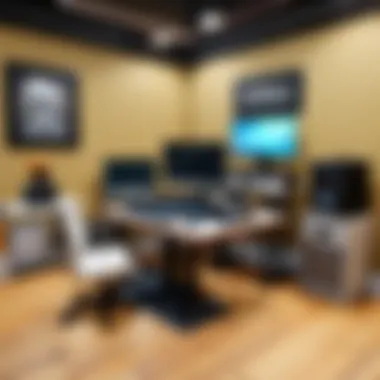

Additionally, the use of sound distortion in games like Hyper Light Drifter speaks to the power of ambiance. The distorted echoes and melodic glitches create an eerie atmosphere, where players feel they are traversing an otherworldly landscape. With each step, the soundscape reflects the desolation and beauty, prompting players to connect emotionally with their environment.
In summary, exploring distortion in popular games, such as those on Roblox and creative indie titles, unveils a complex interplay between sound and gameplay that can profoundly influence player experience. Distortion is embraced not merely as a technical tool but as a narrative device, enhancing the emotional resonance of gaming contexts.
Artistic Choices and Distortion
The use of distortion sound effects in gaming isn't merely about altering audio; it's an art form that can shape the player's perception and emotional experience. When developers weave these sounds intricately into the fabric of their games, the narrative deepens, characters feel more alive, and the entire ambiance transforms. In this section, we'll examine how distortion plays a crucial role in aligning sound design with narrative and customizing character soundscapes.
Aligning Sound Design with Narrative
A well-crafted sound design acts much like a thread running through a story, connecting all elements into a cohesive experience. Distortion effects, when applied thoughtfully, can amplify the narrative's emotional weight. For instance, in a horror game, distorted whispers can heighten fear and tension, making players feel that something sinister lurks just out of sight. In contrast, a fantasy RPG might use bright, distorted chimes to signify magical moments, simultaneously engaging and surprising players.
It’s essential to consider how distortion enhances storytelling:
- Mood Setting: Distortion can set or shift the mood. A treehouse may sound idyllic with gentle echoes but may morph into jarring distortion if a creature is lurking nearby.
- Character Development: Each character can have a unique sound signature. A hero might have a resolute tone, whereas a villain could be represented by eerie, discordant effects, highlighting their nature.
- Player Engagement: Sounds resonate with players, creating an emotional connection. A climactic moment intensified by distortion can lead to heightened adrenaline, drawing the player deeper into the experience.
"Sound design is as integral as visuals in storytelling. Distortion effects add layers of meaning and tension that visuals sometimes can't capture."
Character Soundscape Customization
Character soundscapes—a term often used to describe the auditory backdrop accompanying a figure—can significantly benefit from distortion effects. Each character in a game might convey different feelings through their sounds. Think of it as giving life to characters not just through dialogues or movements, but through their very audio signatures. This technique ranges from minor sound tweaks to more profound distortion effects that change how players perceive their favorite avatars.
Here’s how customization operates:
- Unique Identifiers: A character's steps can echo in distinct ways. For a nimble thief, footsteps could be sharp and quick, whereas a knight's march might sound heavy and weighted. Distortion, applied creatively, can exaggerate these characteristics.
- In-Game Progression: As characters develop through the game, a player’s soundscape can shift. Imagine a character facing treacherous challenges; their once bright and clear sound could gradually develop a distorted quality, signifying struggles and growth.
- Emphasizing Relationships: Utilizing distortion can also highlight relationships between characters. When allies are near, a warm, harmonic distortion might draw close, whereas antagonists could be enveloped in colder, harsher sounds.
This approach not only enhances gameplay but undeniably enriches narrative elements, allowing for a fully immersive experience. By carefully manipulating distortion effects, game developers can craft a unique auditory signature that resonates with both the gameplay and the larger story being told.
Emotional Impact of Distortion Effects
The emotional resonance of any sound in a game is profound, and distortion effects play a pivotal role in amplifying this experience. Through various manipulations, these effects can stir a range of feelings—from discomfort to exhilaration—allowing players to forge a deeper connection with the game's narrative and environment. Understanding the emotional impact of such effects is essential for developers who aspire to create immersive experiences.
At its core, distortion can evoke specific responses and transport players into the heart of the action. Techniques that involve clipping, fuzzing, or overdriving create audio textures that feel alive, gritty, and intense. This not only enhances realism but also enriches the storytelling aspects of the game. For example, the distorted sounds in a horror game can heighten anxiety, while in an adventure title, they may inject an exhilarating sense of freedom. The importance of this manipulation cannot be overstated—it is the difference between a player merely observing and one who is experiencing an emotional journey.
Eliciting Player Reactions
Eliciting a strong reaction is paramount, especially in gaming where emotional engagement can dictate overall enjoyment. Distortion effects can be effectively used to trigger visceral responses. Imagine navigating through a dark, abandoned space in a game, where the sudden introduction of distortion echoes hauntingly around the player. It’s a technique that not only surprises but shocks, creating a deeper psychological impact.
The depth of this reaction varies from player to player, but some elements remain constant. Consider these factors:
- Volume and Intensity: A sudden spike in distortion can jolt a player out of complacency, making them feel the urgency of their in-game situation.
- Texture of Sound: The rawness of a distorted guitar riff or the heaviness of a feedback loop can resonate on an emotional level, often linking back to personal experiences.
- Contextual Relevance: When distortion aligns with the narrative—a battle scene accompanied by screeching distortion —it can transcend mere audio to become a catalyst for memory and adrenaline.
Beyond mere reaction, distortion affects how players interpret and engage with their surroundings. The sound may influence decision-making during high-stakes moments. This relationship creates a cycle of feedback, where the audio informs the player's emotional state, and in turn, their choices feed back into the game's narrative.
Building Tension and Anticipation
Building tension is an art form in game design, and distortion is a highly effective tool in this process. The gradual layering of distorted sounds can heighten anticipation, increasing the stakes for the player. Picture a tense scene where footsteps echo, interspersed with ominous distorted tones, signaling an impending confrontation. This careful construction of sound can raise the anxiety levels, compelling the player to question what lies ahead.
Effective strategies in this space include:
- Dynamic Variation: As a scene progresses, altering the levels of distortion can draw players deeper into the unfolding chaos. Starting with subtle background noise and escalating to overwhelmingly distorted crescendos builds suspense.
- Timing and Pacing: Delaying the introduction of distortion can create a false sense of security until it suddenly bursts forth, shaking the player’s composure.
- Contextual Clarity: Pairing distortion with visual cues ensures that players don’t feel lost. A clear narrative context helps them understand why the tension is building, creating a robust emotional response.
A well-implemented distortion not only entertains but engages the player on a deeper level, opening up channels of suspense and emotional investment that are hard to replicate through visuals alone. Clearly, the strategic use of distortion can turn an ordinary gaming experience into one that keeps players on the edge of their seats, eagerly awaiting what will happen next.
"In the hands of skilled developers, sound becomes more than just a background element; it transforms into an emotional engine that drives player engagement and narrative depth."
Challenges in Using Distortion Effects
In the realm of game audio, distortion effects have become a double-edged sword. On one side, they offer a vibrant tool for enhancing sound, but on the other, they present some headaches for developers. This section tackles the hurdles that come along with utilizing distortion sound effects. It's crucial to strike a balance. While distortion can elevate the audio experience, there are specific challenges that must be navigated.
Avoiding Overuse and Audio Clutter
When it comes to distortion, moderation is key. Just like too much salt can ruin a traditionally tasty dish, overusing distortion can muddle the clarity of sound in a game. Applying distortion liberally can lead to a messy audio landscape, which ultimately turns players off rather than immersing them in their gaming journey.
- Weight of Overuse: Overloading sounds with distortion may lead to audio fatigue, where players feel overwhelmed instead of engaged. Think of it this way: if every sound effect in a game screams for attention, the player may find it hard to focus on any single element.
- Detecting the Sweet Spot: Achieving the right amount of distortion requires a delicate touch. Designers should learn to listen—truly listen—to how sounds interact in a game. Finding that sweet spot means knowing when a sound is strong enough to convey its purpose without losing its essence.
An example drawn from experience comes from a popular horror game which had players on the edge of their seats. The developers expertly used distortion during sudden jumpscares but kept other auditory elements clean, allowing the tension to build naturally.
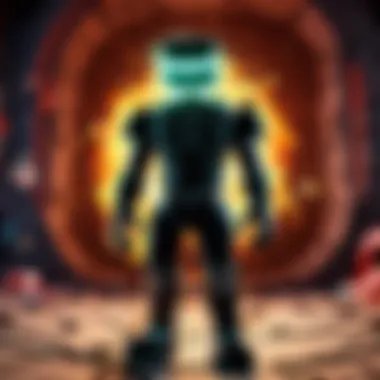

"Sound is often the unsung hero of experiences, guiding emotions without the player noticing its subtle nuances."
Balancing Game Audio Elements
Balancing various audio elements in a game can feel like walking a tightrope; one misstep and the entire experience can wobble. Just as in a conversation, where too many people speaking at once can lead to chaos, game audio must maintain coherence. Each audio layer should complement the others; otherwise, the impact of distortion can be easily lost.
- Layering Techniques: It's essential to consider every sound element—from background music to minute character sounds. These layers ought to fit seamlessly. A striking entrance of distortion in one area can clash if the other sounds are not designed thoughtfully.
- Finding Harmony: Tools such as equalizers can help balance these elements. For instance, if distortion is added to a gunshot sound in a first-person shooter, ensuring that the background audio is not overly noisy will help the punch land more effectively.
By creating a compelling audio environment, designers can maintain player engagement without overwhelming them.
Future Trends in Distortion Sound Effects
As we venture deeper into the evolving landscape of gaming, the significance of distortion sound effects continues to grow. These effects not only enrich the audio aesthetic but also serve as a crucial tool in enhancing player engagement. Keeping an eye on future trends can help developers anticipate shifts in sound design, enabling them to push creative boundaries and foster deeper player connections. This discussion will delve into the advancements in audio technology and the rise of AI in sound design, illustrating how these innovations are reshaping the sonic experience in games.
Advancements in Audio Technology
The technological landscape is always on the move, and audio technology is no exception. With each passing year, we see significant upgrades in the tools and techniques available to sound designers. The ability to record and manipulate sounds with unparalleled fidelity is opening up new avenues for exploration. For instance, spatial audio allows developers to create a 3D sound environment, making distortion effects not only a gameplay feature but also a medium of storytelling.
Some key advancements include:
- High-Resolution Audio: The quality of audio has reached astonishing heights. It ensures that distortion effects not only create a mood but are also crisp and clear, allowing players to experience sounds that feel real.
- Real-Time Processing: Gone are the days of pre-rendered audio. Modern engines can process sound in real-time, allowing distortion to react to player actions in dynamic ways.
- Adaptive Audio Systems: These systems make it possible for soundscape changes based on player choices or in-game events. This adaptability makes distortion effects feel more organic and integrated into the gameplay.
The use of convolution reverb, for example, is becoming more prevalent. This technology allows for the recreation of real-world acoustics in a game. Now, when a character steps into a cavern, the distortion of their voice or other sounds can be realistically altered, providing a more immersive experience.
The Role of AI in Sound Design
Artificial Intelligence is carving its niche within sound design, taking distortion effects to new heights. With AI, there's a potential to create highly personalized experiences that respond intuitively to players' behavior and preferences. AI not only automates processes but can also generate unique sounds, making each player's experience distinct.
Here are ways AI is impacting distortion in games:
- Sound Generation: AI can analyze existing sound libraries and create new distortion samples that fit within specific genres or styles, reducing the time developers spend on sound creation.
- Player Behavior Analysis: By analyzing how players interact with sound, AI can predict and adjust audio elements to heighten immersion. If a player responds positively to certain distortions, the system can learn to enhance these effects in future gameplay.
- Enhanced Audio Mixing: AI algorithms can intelligently mix multiple audio tracks, ensuring a harmonious blend of soundscapes. This leads to a well-balanced experience where distortion is beautiful rather than overwhelming.
A good dose of distortion can turn a mediocre sound into a highlight, especially as AI tools evolve to make this process smarter.
The End
The role of distortion sound effects in gaming cannot be overstated. These effects not only enhance the overall audio experience but also firmly intertwine with the gameplay itself. From crafting a haunting atmosphere to amplifying the thrill of gameplay, distortion serves various purposes that enrich player interactions and emotions.
In this article, we've discussed how distortion can transform simple soundscapes into vibrant, immersive environments. Each type of distortion—be it overdrive, fuzz, or bitcrushing—adds its unique flair and character, influencing player perception and engagement. Simultaneously, we explored how the balance of sound elements can create clarity amidst complexity, helping players focus on their tasks without overwhelming them.
As we move towards future innovations in the gaming industry, understanding the intricacies of distortion sound effects becomes imperative. This knowledge empowers both developers and enthusiasts to harness the full potential of audio design, adapting to new technologies and player preferences. By investing in experimentation with these effects, creators can ensure that their projects resonate well with audiences, ultimately driving a more connected and memorable gaming experience.
Summary of Key Points
- Distortion sound effects are crucial for establishing atmosphere and enhancing emotional engagement.
- Different types of distortion can serve various purposes, from enhancing gameplay dynamics to creating unique sound identities for characters.
- Balancing audio elements is vital to maintain clarity without overwhelming players.
- The evolution of audio technology continually influences how distortion can be utilized, suggesting a dynamic landscape for sound design in gaming.
Encouragement for Experimentation
As we wrap up this exploration into distortion sound effects, it's essential to encourage creators to embrace experimentation. The world of sound design is not just about following trends or rules; it's about pushing boundaries and innovating.
- Try layering different types of distortion effects in your audio projects. You might just stumble upon something groundbreaking that changes how players experience your game.
- Don’t be afraid to tweak parameters and manipulate sounds in unexpected ways. Sometimes, the most powerful sounds are the result of happy accidents.
- Look for inspiration in unusual sources. Whether it’s nature, urban life, or even other art forms, diverse influences can lead to fresh perspectives on sound design.
By taking these steps, you not only improve your own skills but also mold the future of gaming audio design. Let your creativity flourish, and who knows? You might set the stage for the next big thing in audio effects.
“Innovation distinguishes between a leader and a follower.” – Steve Jobs
Resources for Further Exploration
In any field, continuous learning is vital, and audio design within gaming is no different. Exploring resources dedicated to distortion sound effects can broaden one's knowledge and enhance practical skills. This article scratches the surface, but tapping into deeper, curated resources offers fresh insights and tools for better sound design in games. The elements of distortion significantly impact player engagement and atmosphere, making it essential for creators at all levels to keep their skills sharp and informed.
Recommended Reading
Diving into literature can be an illuminating journey. Books and articles focusing on sound design, specifically distortion, not only offer theoretical foundations but also practical examples that can inspire creativity. Here are a few notable recommendations:
- "The Art of Sound Design for Video Games" by David Sonnenschein: This title discusses various audio techniques and how they serve the narrative and gameplay, making it indispensable for understanding the full weight of sound choices, including distortion.
- "Mixing Secrets for the Small Studio" by Mike Senior: An insightful read on mixing techniques, where distortion plays a crucial part. Although it’s focused on studio sound, the principles are highly transferable to gaming.
- Online articles from reputable websites such as Wikipedia and Britannica often cover the evolution of distortion effects and their technical breakdowns, providing a historical context that enriches understanding.
Exploring forums like Reddit can also be enlightening. There, experienced developers share best practices, challenges, and personal projects that often feature distortion as a central theme.
Online Tutorials and Workshops
Hands-on learning is absorbed differently than passive reading. Engaging in workshops and online tutorials can expedite the learning curve. Here are some worthwhile options available:
- Skillshare Courses on Audio Design: Numerous instructors specialize in game audio, offering step-by-step video tutorials that delve into distortion sound effects. These courses provide practical insights into both conceptual frameworks and technical know-how.
- YouTube Channels like "The Sound Architect": This channel has comprehensive tutorials and discussions surrounding specific sound design techniques, including how to incorporate distortion effectively into game audio. The visual aspect adds clarity to complex ideas.
- Workshops hosted by universities or professional sound organizations: Keep an eye on offerings from reputable institutions. Online formats have expanded access, and many workshops focus on practical applications involving distortion, featuring experienced sound designers as instructors.
Ultimately, these resources serve to embellish your toolkit. Committing to continual learning cultivates not only technical proficiency but also innovative approaches to sound design in gaming. A richer understanding of distortion leads to more nuanced player experiences, allowing you to create games that truly resonate.






